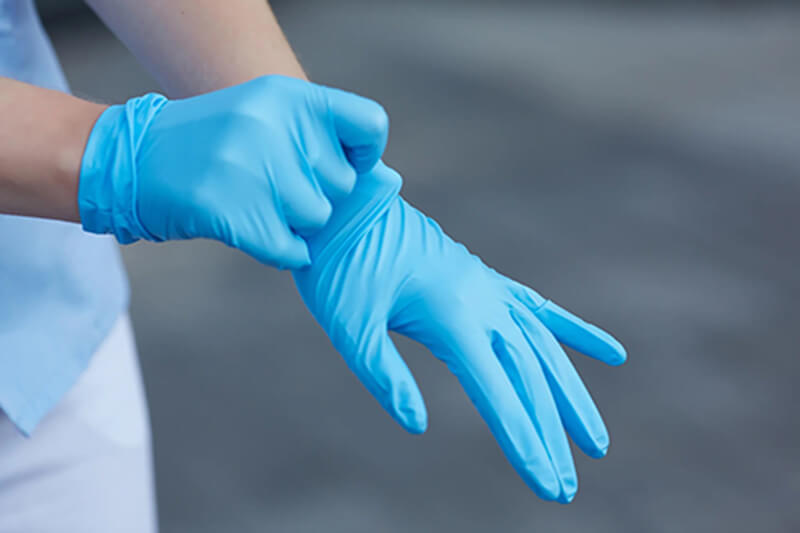Disposable gloves are essential in healthcare, food handling, industrial work, and daily protection. However, the choice between powdered and powder-free gloves remains a common dilemma. This blog explores their differences in manufacturing, use cases, safety risks, and industry trends to help you make informed decisions.
1. Core Differences: Manufacturing and Lubrication
Powdered Gloves
Powdered gloves are coated with cornstarch or talcum powder during production to reduce friction and ease donning. The powder acts as a lubricant, especially useful for sweaty hands or rapid glove changes (https://glovenation.com/blogs/news/blog-powdered-vs-powderfree-gloves).
Pros:
- Quick to wear, ideal for tasks requiring frequent glove changes (e.g., assembly lines, cleaning).
- Cost-effective due to simpler manufacturing .
Cons:
- Powder residue may cause skin irritation, allergies, or contamination .
- Banned in medical settings (e.g., FDA regulations) due to infection and respiratory risks .
Powder-Free Gloves
These gloves undergo chlorination or polymer coating to eliminate powder. The process involves rinsing gloves in chlorine solutions to achieve a smooth interior
Pros:
- Hygienic, suitable for sterile environments (e.g., surgeries, labs) .
- Lower allergy risks and no powder-related contamination .
Cons:
- Slightly harder to don, especially with dry hands.
- More expensive due to additional processing steps .
2. Ideal Applications: Matching Gloves to Tasks
When to Use Powdered Gloves
- Industrial Work: Assembly lines, construction, or janitorial tasks where speed and cost matter .
- Short-Term Use: Non-critical tasks like gardening or quick repairs.
When to Use Powder-Free Gloves
- Healthcare: Mandatory in surgeries and patient care to prevent infections and latex protein aerosolization .
- Food Handling: Avoid powder contamination in food prep or packaging .
- Electronics/Labs: Prevent dust interference with sensitive equipment .
3. Health Risks: Powder vs. Powder-Free
Risks of Powdered Gloves
- Allergies: Cornstarch or latex proteins can trigger skin rashes, respiratory issues (e.g., asthma), or severe Type I hypersensitivity .
- Infection Spread: Powder particles may harbor bacteria, increasing surgical site infections (SSIs) or wound granulomas .
- Long-Term Hazards: Inhalation of aerosolized powder linked to lung inflammation and occupational asthma .
Safety of Powder-Free Gloves
- No powder-related risks but may contain trace chemicals (e.g., accelerators in nitrile gloves). Hypoallergenic options (accelerator-free) are available for sensitive users .
4. Industry Standards and Regulations
- Medical Ban: The FDA prohibited powdered medical gloves in 2016 due to patient safety concerns. The EU and other regions followed suit .
- Food Safety: While some powdered nitrile gloves comply with FDA standards (e.g., Top Glove’s food-grade products ), most food industries prefer powder-free to minimize cross-contamination .
- Manufacturing Standards: Powder-free gloves dominate certifications like ISO 13485 (medical devices) and EN 455 (surgical gloves)
5. How to Choose the Right Gloves
-
Prioritize Safety:
- For healthcare, labs, or food prep: Always choose powder-free .
- For industrial use: Powdered gloves save costs if hygiene is secondary .
-
Check Certifications:
- Medical gloves: Look for FDA/ISO compliance.
- Food-grade gloves: Ensure FDA 21 CFR 177.2600 or EU Regulation 1935/2004 .
-
Comfort and Fit:
- Powder-free nitrile gloves with textured grips enhance dexterity for precision tasks .
- Size matters: Tight gloves cause fatigue; loose ones risk slippage.
6. Emerging Trends
- Decline of Powdered Gloves: Global healthcare shifts toward powder-free alternatives, driven by stricter regulations and allergy awareness.
- Innovation in Coatings: Polymer and silicone coatings improve powder-free glove comfort without compromising safety.
Conclusion
Powdered gloves excel in cost and convenience for non-critical tasks, while powder-free gloves dominate in safety-critical fields like healthcare and food service. Always align your choice with industry standards, user health, and task requirements. As regulations evolve, powder-free gloves are set to become the universal standard for hygiene and safety.








